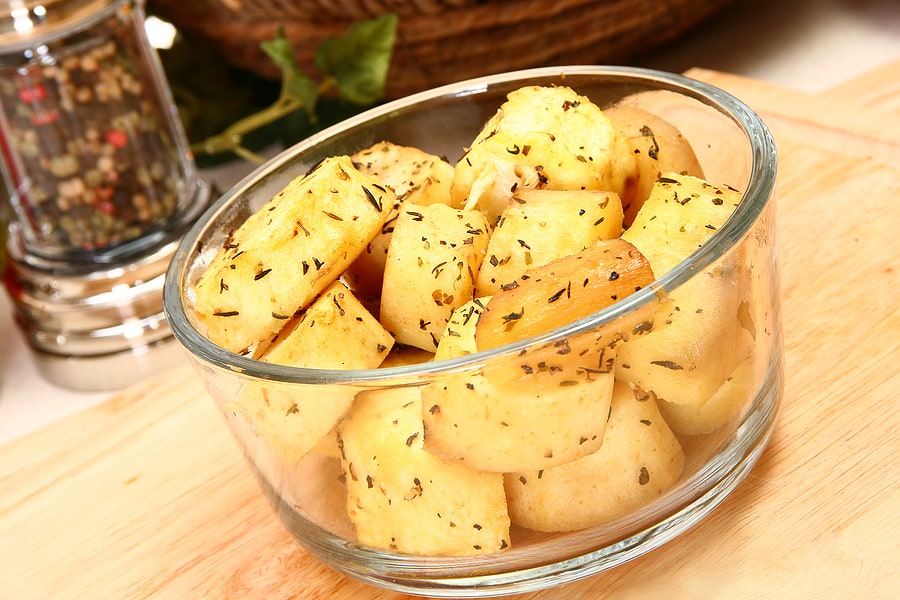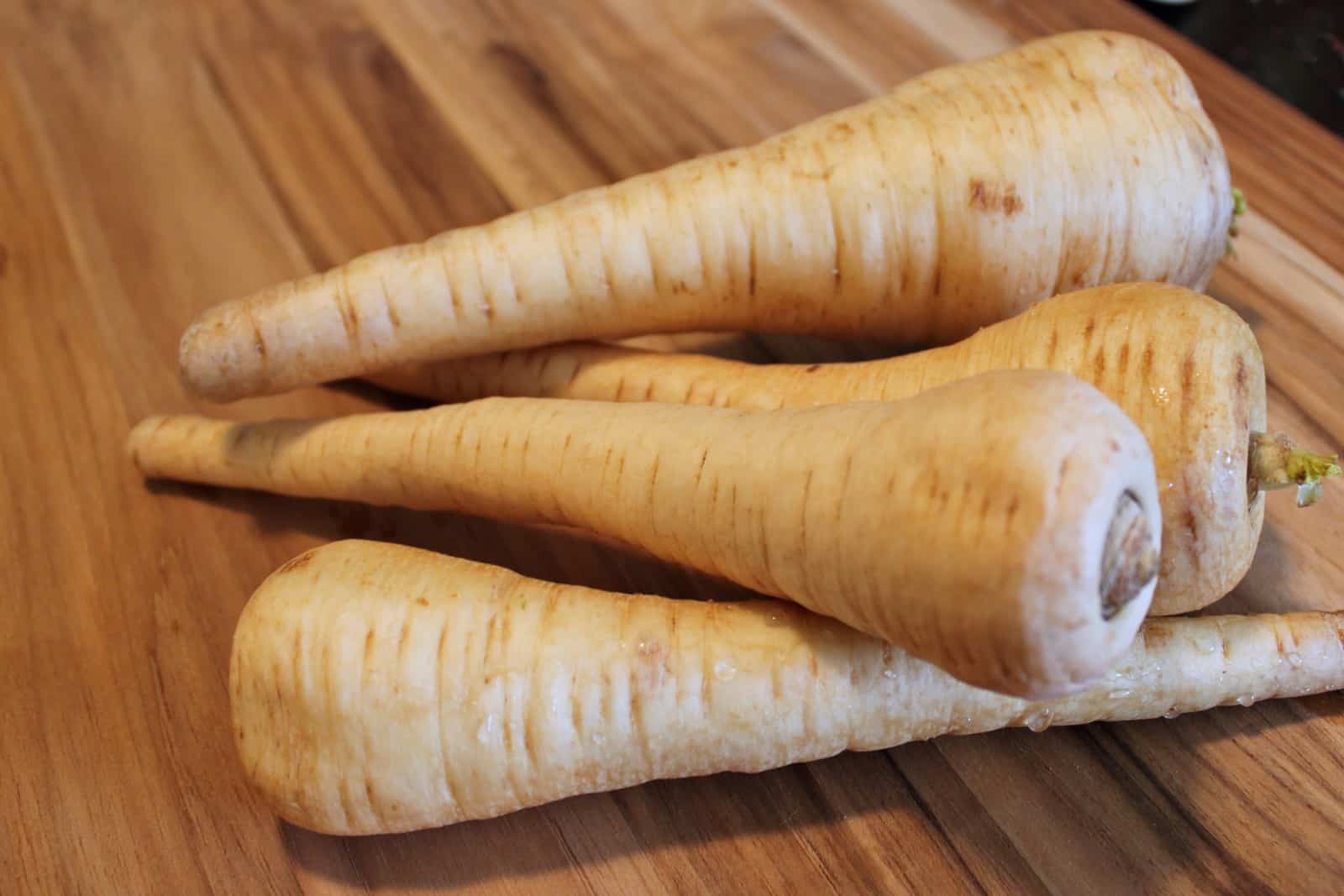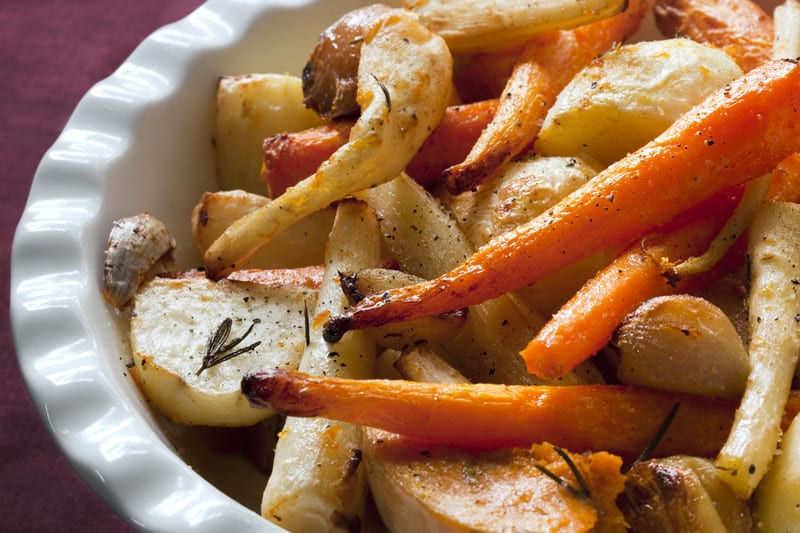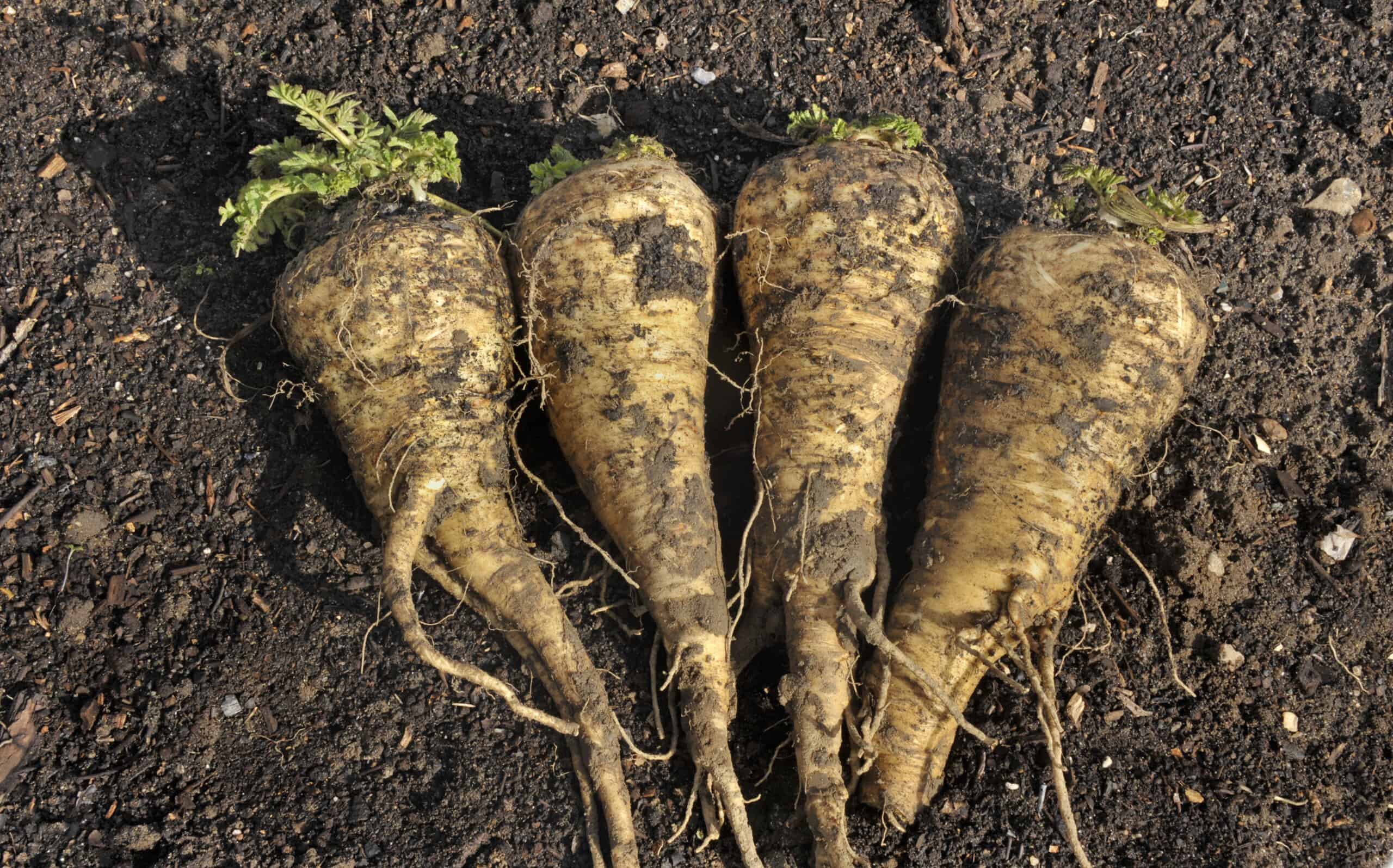Parsnips can be peeled, sliced, and sautéed or steamed like carrots. You can boil and mash them with butter and cream like potatoes.
Parsnips can be cut into chunks and added to soups or stews or baked in the oven with meat stock and butter. Roast parsnips with beef, pork, or chicken.
You can parboil and fry parsnips like potatoes. Slice parsnips into rings, dip in batter, deep-fry, and eat as fritters.
Grate parsnips into salads or add chopped and peeled to casseroles or soups.
Parsnips can be lightly cooked and eaten cold.
After the first frost of the year, the starch in the parsnip converts to sugar and that is when parsnip eating gets good.

The parsnip has a pleasantly sweet taste that combined with brown sugar, maple syrup, cream, apples, or spices such as nutmeg, ginger, cinnamon, or allspice, for instance, make it all the more appealing. And its sweetness offers a welcome contrast to sour, salty, or bitter foods.
But that is not to say that the parsnip leans only to the sweet side; it can be chunked and added to beef stew or combined with potatoes for mashing. It can be paired with chervil, dill, and parsley. It can be baked, boiled, braised, breaded, grilled, mashed, pureed, roasted, sautéed, or steamed.
If you’d like to get started serving parsnips, the easiest way is to simply cook them like you would carrots. If you want to get fancy, put them around a beef roast and let them cook in the meat juices. Then serve hot on a crisp fall day!
Kitchen Helpers from Amazon:
- Oster Vegetable Steamer
- Chef’s Knives Set of 6
- EZ Off Jar Opener for Weak Hands
- Pepper Core Remover Stainless Steel
- Kitchen Utensils – Set of 35
How to choose parsnips
When choosing parsnip, look for small to medium-sized roots that are not pitted. Size has nothing to do with how good a parsnip tastes—remember its age. You should avoid parsnips that are limp or shriveled or spotted.
- Select parsnips that are small to medium in size and well-shaped with uniform color.
- Avoid limp, shriveled, or spotted parsnips or those that have splits or brown spots.
- Large parsnips may have tough or woody cores.
- Young roots will be more tender and have a milder flavor than mature, large ones.
- If the parsnip’s green top is attached, it should look fresh. However, the attached tops will drain the root of nutrients.
- The peak season for parsnips is fall and winter. The first frost of autumn will convert the parsnip’s starch to sugar and give it a sweet, hazelnut flavor. The parsnip is a hardy root vegetable that will continue to improve in flavor even as the weather turns to freeze.
How to store parsnips
Parsnips can be stored in the refrigerator for up to a month. Wrap it in a paper towel, placed it in a plastic bag, and put it in the coldest part of the refrigerator.
- The parsnip will keep wrapped in a paper towel in a perforated plastic bag in the refrigerator for up to 2 weeks. You can keep the parsnip in the refrigerator for 2 to 4 months, but some of the flavor and texture will be lost.
- Freeze parsnips whole or in chunks; first, blanch the entire parsnip for 5 minutes or cut parsnips for 3 minutes, then freeze.

How to prep parsnips for cooking
When you go to prepare your parsnip, trim off the ends and knobs and peel before cooking. (The outer layer of raw parsnip can be added to coleslaw.) If the core seems tough or stringy you can cut it out.
- Peel parsnips only if their skins are tough or have been waxed. Otherwise, scrub and peel the parsnip with a vegetable brush under running water as you would a carrot.
- The skin of the parsnip is easily removed after cooking.
- Old parsnips may have to be cored. They can be hard, fibrous, and tasteless.
- The flesh of cut or skinned parsnips will darken on contact with the air. Cut parsnips should be immediately placed in lemon or vinegar water to avoid discoloring.
Ways to cook parsnips
Parsnips can be cooked whole or sliced crosswise into rings of equal thickness or lengthwise into halves. You can quarter or julienne strips of equal thickness. Thinner strips may be diced.
- Before frying or cooking parsnips first parboil the roots for 5 to 10 minutes and then refresh them in cold water for 10 minutes before cooking further.
- Simmer parsnips in a covered container until tender; whole roots will cook in 15 to 30 minutes, and pieces in 5 to 15 minutes depending on size.
- Steaming whole parsnips will take 20 to 40 minutes, and pieces 5 to 10 minutes less.
- Sauté or stir-fry parsnips without coating or batter for 10 to 15 minutes or until tender.
- Pan-fry or deep-fat fry parsnips in a wet batter until the crust is golden brown.
- Parsnips can be used in braises and casseroles; cook until they are tender, about 30 to 45 minutes.
How to boil parsnips
- Scrub each parsnip with a vegetable brush. Trim the ends.
- Cut roots into 1-inch pieces.
- Add 2 inches of water to a medium saucepan and bring to a boil. Add parsnips.
- Cook parsnip pieces for 10 minutes, or until they are fork-tender.
- Drain and serve hot.
How to mash parsnips
- Boil 1-inch pieces (see above) and drain.
- Pour the boiled parsnip pieces into a large bowl.
- Use a fork or potato masher to coarsely mash the pieces.
- Season with butter and cream just as you would mashed potatoes.
Boiled and mashed parsnips can be blended into soups or stews. Mashed parsnips will add creaminess and body to soups or stews in place of flour or cornstarch.

How to roast parsnips
- Preheat the oven to 425 degrees F.
- Scrub the outer skin with a vegetable brush. Do not peel. Trim the ends.
- Cut the parsnips into pieces about 1 inch wide.
- Toss pieces with olive, salt, and pepper, or brown sugar, paprika, or chili powder.
- Arrange pieces on a baking sheet or ovenproof dish.
- Roast for 20 to 25 minutes, or until the largest pieces are fork-tender.
Parsnips can be baked alone or with other roots such as carrots and vegetables cut to equal size.
How to sauté parsnips
- Heat olive oil in a medium skillet over medium-high heat.
- Scrub the outer skin with a vegetable brush. Do not peel. Trim the ends.
- Cut the parsnips into three-quarter-inch pieces. Or, cut the roots into thin strips or matchsticks.
- Add parsnip pieces to the skillet. (You can add herbs such as rosemary or thyme at the same time.)
- Cook for 5 to 10 minutes until pieces are fork-tender stirring every few minutes. Season with salt and pepper.
- Serve hot; drizzle with melted butter if you like.
How to serve parsnips
- Bake, boil, grill, steam, or mash parsnips much the same as carrots. Parsnips can be prepared as you would carrots, salsify, or turnips. Parsnips will replace those vegetables in most recipes.
- Serve parsnips alone or mixed with peas, broccoli, cauliflower, celery, onion, summer squash, potatoes, or a combination of these. Top parsnips with plain or flavored butter or margarine.
- Parboil parsnips and drain, then stew in butter and garnish with parsley or a sprinkling of Parmesan cheese.
- Steam parsnips whole, slice them length-wise, and pan-glaze with butter, brown sugar, and nutmeg or garnish them with chopped walnuts and a dash of sweet sherry.
- Parsnips will add a nut-like flavor to stews and soups. Place them around a beef roast to cook in the meat juices, or puree and add butter and seasoning.
- Serve parsnips puréed or fried like Fresh fires or glazed like carrots. Serve parsnips cold dressed in a vinaigrette or as a vegetable side dish.
Parsnip flavor partners
- Parsnips have a flavor affinity for apples, brown butter, brown sugar, cream, curry, leeks, oranges, root vegetables, stews, ragouts, and truffles.
- Season parsnips with salt, pepper, dill, ginger, onion, parsley, nutmeg, mace, clove, cinnamon, allspice, caraway seed, celery seed, mint, rosemary, anise, marjoram, thyme, tarragon, bay leaf, fennel, mustard, curry powder, cumin, coriander, or brown sugar.
Parsnip nutrition
A half-cup of fresh sliced cooked parsnip contains 63 calories (a half-cup of raw sliced about 50 calories) and 15 carbohydrates.
- Parsnips contain some vitamins A, C, and E. Parsnips contain small amounts of iron.
- An average serving contains 66 calories.
- The carbohydrate content of a parsnip is higher than a carrot.

Get to know parsnips
- The parsnip looks like a pale yellow carrot. Its tapering root grows 4 to 9 inches (10-23 cm) long and 2 inches (5 cm) in diameter. The plant forms a rosette of compound celery-like leaves.
- Parsnips can be left in the ground all winter but should be harvested before the second season or they will become fibrous and woody.
- The parsnip is a native of the Mediterranean region and Western Asia. The ancient Romans cultivated parsnips, and during the Middle Ages, the parsnip was valued as both a source of starch and sweetness. It was eaten as a vegetable and as a sweet dish.
- The word “parsnip” comes from the French, pastinaca with the ending “nip” suggesting that it is turnip-like.
- While the parsnip is not wildly popular today, its culinary versatility made it once a staple at winter tables in colder climates particularly before the popularization of the potato.
- The Romans liked parsnips and so did Europeans in medieval times. The parsnip came to America in the 1600s. It had one of its best mentions in the 1898 Boston Cooking-School Cook Book authored by Fanny Farmer.
The botanical name of the parsnip is Pastinaca sativa.
Parsnip articles at Harvest to Table:
How to Harvest and Store Parsnips
Five Quick Ways to Cook and Serve Parsnips
Carrot and Parsnip Growing Problems Troubleshooting
Articles of interest:
Best Herbs for Container Growing
Garden Planning Books at Amazon:
- Vegetable Garden Almanac & Planner
- Kitchen Garden Grower’s Guide Vegetable Encyclopedia
- Vegetable Garden Grower’s Guide
- Tomato Grower’s Answer Book
More kitchen tips:
Bring your harvest to the table. Kitchen prep tips and easy recipes for the vegetables you grow. Click below for vegetable prep and recipes you can use now.
- Almonds
- Apples
- Apricot
- Aprium
- Artichoke
- Arugula
- Asparagus
- Avocado
- Bamboo Shoots
- Banana
- Basil
- Beans, Dried
- Beans. Long
- Beans, Shell
- Beans, Snap
- Beets
- Bitter Melon
- Blackberry
- Bok Choy
- Broccoli
- Broccoli Raab
- Brussels Sprouts
- Cabbage
- Cardoon
- Carrots
- Cauliflower
- Celeriac
- Celery
- Chard
- Chayote Squash
- Cherimoya
- Cherries
- Chestnut
- Chickpea
- Chinese Cabbage
- Chives
- Cilantro
- Citron
- Clementine
- Collards
- Coriander
- Corn, Sweet
- Corn, Baby
- Corn Salad, Mache
- Cranberry
- Cress
- Cucumber
- Daikon
- Dandelion
- Dill
- Eggplant
- Endive, Belgian
- Endive and Escarole
- Fava Beans
- Fig
- Florence Fennel
- Garlic
- Ginger
- Grapefruit
- Grapes
- Guava
- Horseradish
- Jerusalem Artichoke
- Jicama
- Jujube
- Kale
- Kiwifruit
- Kohlrabi
- Kumquat
- Leeks
- Lemongrass
- Lemons
- Lettuce
- Lime
- Mache (Corn Salad)
- Mandarin Orange
- Mango
- Maple Syrup
- Marjoram
- Melons
- Michihili
- Mint
- Mizuna
- Mushrooms
- Mushrooms, Cremini
- Mustard Greens
- Napa Cabbage
- Nectarine
- Okra
- Olives
- Olive oil
- Onions
- Oranges
- Oregano
- Parsley
- Parsley Root
- Parsnips
- Passion Fruit
- Pawpaw
- Peaches
- Pears
- Peas, Garden Snap
- Peas, Snow
- Pei Tsai
- Peppers, Chili
- Peppers, Sweet
- Persimmon
- Pineapple
- Pineapple Guava
- Plantain
- Plums
- Pluots
- Pomegranate
- Potatoes
- Prickly Pear
- Pumpkin
- Quince
- Radicchio
- Radishes
- Raspberries
- Rosemary
- Rhubarb
- Rutabaga
- Sage
- Salsify
- Sauerkraut
- Savory
- Shallots
- Sorrel
- Spinach
- Squash, Summer
- Squash, Winter
- Strawberries
- Sunchokes
- Sunflower
- Sweet Potato
- Swiss Chard
- Tangerine
- Taro
- Tarragon
- Thyme
- Tomatillo
- Tomato
- Turnip
- Turnip Greens
- Yams















